During the spring and summer seasons in New Jersey, one can commonly find yellow birds like warblers, orioles, and tanagers. However, in the winter, the American Goldfinch stands as the most frequently sighted yellow bird in the region.
To assist you in identifying the yellow birds you spot in New Jersey, this guide provides pictures, identification information, song recordings, and details about their migration patterns.
The majority of yellow birds in New Jersey belong to the warbler, oriole, or tanager species, with some female birds displaying distinct differences from their male counterparts.
By utilizing the comprehensive information in this guide, identifying yellow birds will become much easier. The list of yellow birds is arranged in the order of their common occurrence in New Jersey during the spring and summer months of May and June, based on ebird checklists.
Yellow birds found in New Jersey throughout the year include the American Goldfinch, Pine Warbler, Eastern Meadowlark, and Yellow-headed Blackbird.
During the summer season, one can spot Common Yellowthroats, Cedar Waxwings, Yellow Warblers, American Redstarts, Baltimore Orioles, Scarlet Tanagers, White-eyed Vireos, Prairie Warblers, Orchard Orioles, Blue-winged Warblers, Yellow-throated Vireos, Hooded Warblers, Yellow-throated Warblers, Prothonotary Warblers, and Summer Tanagers.
In the winter, the Orange-crowned Warbler and Western Kingbird make appearances as yellow birds in New Jersey. And during migration periods, one can expect to see Palm Warblers, Magnolia Warblers, Black-throated Green Warblers, Nashville Warblers, Cape May Warblers, Canada Warblers, Wilson’s Warblers, Dickcissels, and Evening Grosbeaks.
So read on to successfully identify those yellow birds you have recently spotted.
30 Yellow Birds in New Jersey:
1. American Goldfinch
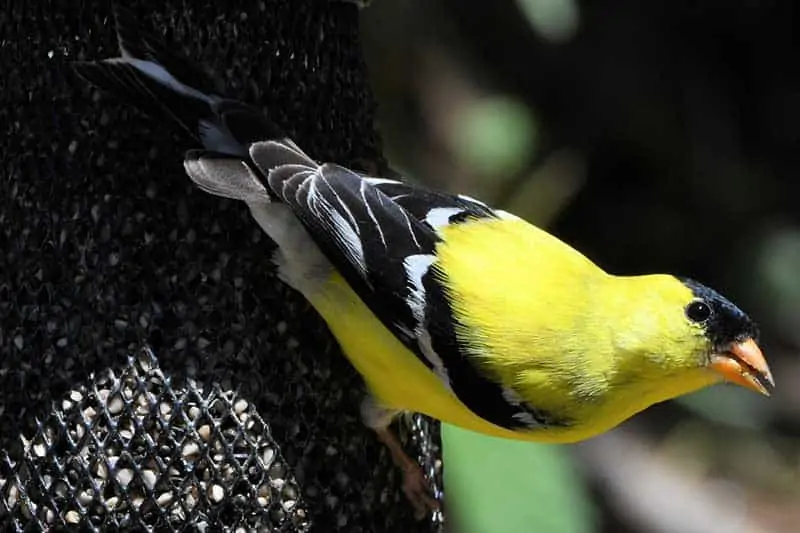
American Goldfinches can be found in New Jersey throughout the year, but their numbers increase during the breeding season. During this time, they are observed in 37% of summer checklists and 19% of winter checklists submitted by birdwatchers in the state.
These birds are highly regarded due to the vibrant yellow and black plumage of the males in spring. In contrast, females and males during winter exhibit duller brown colors.
Spinus tristis
Length: 4.3-5.1 in (11-13 cm)
Weight: 0.4-0.7 oz (11-20 g)
Wingspan: 7.5-8.7 in (19-22 cm)
American Goldfinches are widespread across North America and are generally year-round residents. However, those that breed in Canada and the Midwest migrate to southern US states for the winter.
American Goldfinches can be found foraging in weedy fields, overgrown areas, suburbs, parks, and backyards. They primarily feed on sunflower, thistle, and aster plants.
Song of the American Goldfinch:
The nests of American Goldfinches are typically located in shrubs and constructed using rootlets and woven plant materials held together with spider webs. They lay up to seven eggs, which take about two weeks to hatch, and the young leave the nest within two to two and a half weeks.
To attract American Goldfinches to your backyard, consider planting thistles and milkweed. They are regular visitors to bird feeders and have a preference for sunflower seeds and nyjer seeds.
Fun Fact: Due to their vegetarian diet, American Goldfinches are not suitable hosts for cowbird chicks, leading to their demise within a few days.
2. Common Yellowthroat

Common Yellowthroats spend the breeding season in New Jersey and are primarily observed from April to December. They appear in 38% of summer checklists.
These small songbirds exhibit brownish plumage on their backs and vibrant yellow coloring underneath. The males have black masks on their faces, while the brightness of yellow can vary geographically, with some populations appearing more olive-toned.
Geothlypis trichas
Length: 4.3-5.1 in (11-13 cm)
Weight: 0.3-0.3 oz (9-10 g)
Wingspan: 5.9-7.5 in (15-19 cm)
Common Yellowthroats breed across most of North America, excluding Alaska and northern Canada. Some individuals remain along the Gulf Coast and Pacific Southwest throughout the year. During migration, they head south for winter.
These birds can often be found in marshy or wetland areas and brushy fields, residing in dense, tangled vegetation.
Song of the Common Yellowthroat:
Credit: Paul Marvin, XC629250. Accessible at www.xeno-canto.org/629250.
Nests of Common Yellowthroats are constructed by females close to the ground in marshy regions, supported by reeds. The nests are made from grass, sedges, and leaves, forming a platform. They lay up to six eggs, which take around twelve days to hatch, and the young leave the nest in a similar timeframe.
To attract Common Yellowthroats to larger backyards, provide dense vegetation and native plants that attract insects.
Fun Fact: The black mask of the Common Yellowthroat serves as a signal to courting males, leading them to attack fake birds with masks while showing no aggression toward those without masks.
3. Cedar Waxwing
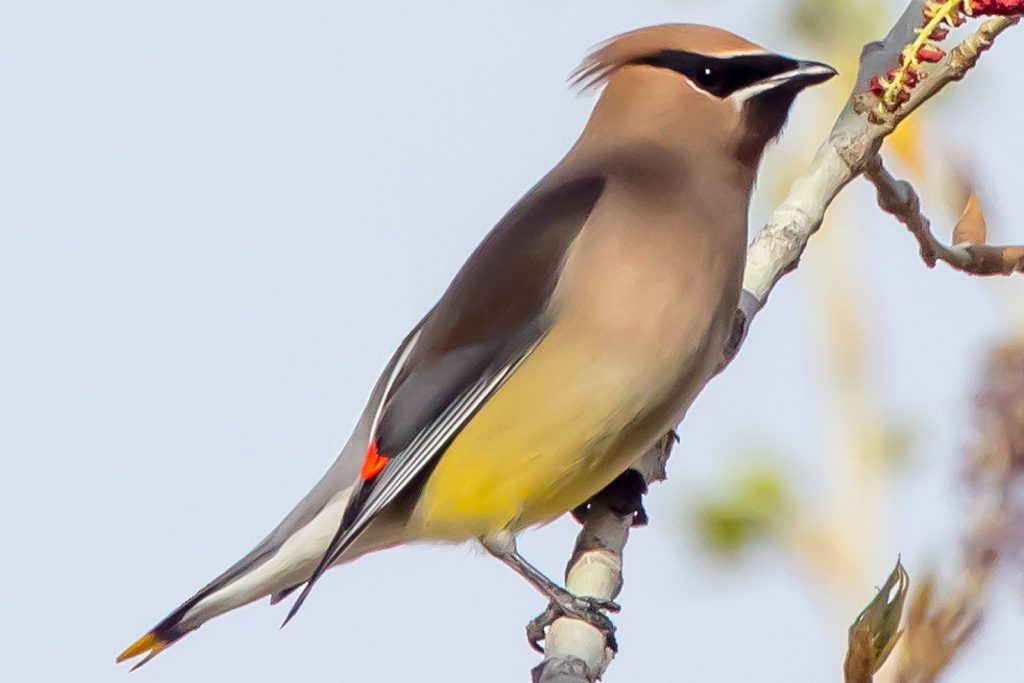
Cedar Waxwings can be observed in New Jersey throughout the year, with the highest sightings during the breeding season from May to November. They are recorded in 18% of summer checklists and 3% of winter checklists in the state.
These elegant and social birds exhibit pale brown plumage on their heads, chests, and crests, fading to gray on their backs, wings, and tails. Their bellies have a pale yellow color, with bright yellow tips on the tail. They also possess a narrow black mask over their eyes and bright red wingtips.
Bombycilla cedrorum
Length: 5.5-6.7 in (14-17 cm)
Weight: 1.1 oz (32 g)
Wingspan: 8.7-11.8 in (22-30 cm)
Cedar Waxwings breed in Canada before migrating to southern US states, Mexico, and Central America for winter. They are year-round residents in northern US states.
These birds can be found in berry bushes, woodlands, grasslands, towns, and along streams. While their primary diet consists of fruit, they also consume insects during the summer months.
Call of the Cedar Waxwing:
Credit: Peter Ward and Ken Hall, XC512254. Accessible at www.xeno-canto.org/512254.
Nests of Cedar Waxwings are constructed in trees using twigs, grass, hair, and plant material. They line the nest with pine needles and soft grass. The birds lay up to six eggs, which take around twelve days to hatch, and another sixteen days for the young to fledge.
To attract Cedar Waxwings to your backyard, consider planting native trees and shrubs that bear small fruit, such as serviceberry, dogwood, juniper, winterberry, and hawthorn. You can also provide fruit on platform feeders.
Fun Fact: Cedar Waxwings exchange small gifts during courtship, passing them between each other.
4. Yellow Warbler
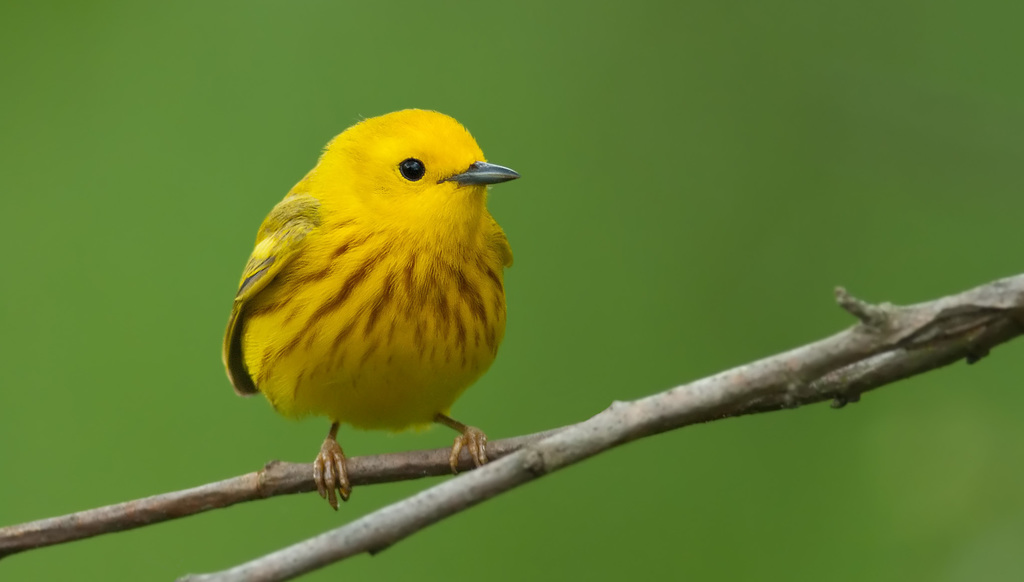
Yellow Warblers are observed during the breeding season in New Jersey and appear in 28% of summer checklists. They arrive in April and commence their migration in October.
These small, bright yellow birds have a yellow-green back, and males display chestnut streaks on their breasts. Females and juveniles are less vibrant in color compared to males.
Setophaga petechia
Length: 4.7-5.1 in (12-13 cm)
Weight: 0.3-0.4 oz (9-11 g)
Wingspan: 6.3-7.9 in (16-20 cm)
Yellow Warblers undertake long-distance migrations, breeding in Canada and the US (excluding southeastern states), and then migrating to Central and South America for winter. However, they can be observed during migration in southeastern US states.
These birds can be found along streams, wetlands, thickets, and field edges, foraging for insects such as caterpillars, midges, beetles, bugs, and wasps.
Song of the Yellow Warbler:
Credit: Richard E. Webster, XC662546. Accessible at www.xeno-canto.org/662546.
Nests of Yellow Warblers are typically located in small trees or shrubs and are constructed from bark, grass, and plant materials woven together and secured with spider webs. The nests are then lined with softer materials like hair, feathers, and plant down.
Yellow Warblers lay up to seven eggs, which take around twelve days to hatch, and another ten days for the young to leave the nest.
To attract Yellow Warblers to your backyard, provide suet, oranges, peanut butter, and plants that bear berries. Additionally, plant native insect-attracting plants without the use of pesticides or excessive tidiness. Birdbaths with fountains near secluded plantings can offer protection as well.
Fun Fact: When cowbirds attempt to lay their eggs in Yellow Warblers’ nests, the warblers often build new nests on top of the intruding eggs, repeating this process up to six times.
5. American Redstart Female
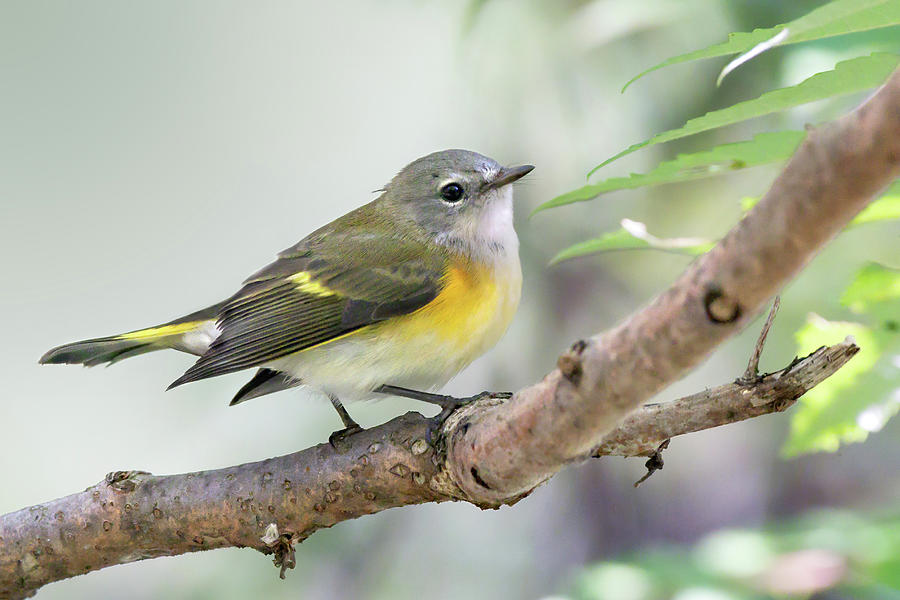
American Redstarts spend the breeding season in New Jersey, with higher numbers observed during migration in May and September. They are recorded in 14% of summer checklists and up to 31% of checklists during migration.
Male American Redstarts showcase predominantly black plumage with bright orange patches and a white belly. Females, on the other hand, display olive-gray coloring instead of black, with numerous yellow patches.
Setophaga ruticilla
Length: 4.3-5.1 in (11-13 cm)
Weight: 0.2-0.3 oz (6-9 g)
Wingspan: 6.3-7.5 in (16-19 cm)
American Redstarts breed in eastern US states, Canada, and northwestern US states. They can also be observed during migration in central and western US states.
These birds can be found in deciduous woodlands, backyards, thickets, and areas with berry-producing plants like serviceberry and magnolia. Their diet mainly consists of insects, but they also consume berries during winter.
Song of the American Redstart:
Credit: Nick Kiehl, XC522368. Accessible at www.xeno-canto.org/522368.
Nests of American Redstarts are positioned near the trunk of trees or large shrubs. They are constructed using bark, grass, and other plant materials. The birds lay up to five eggs, which take just under two weeks to
hatch, and another week or two for the young to leave the nest.
To attract American Redstarts to your backyard, consider planting berry-producing plants such as magnolia and serviceberry.
Fun Fact: American Redstart parents selectively feed specific chicks rather than feeding all of them at once.
6. Baltimore Oriole Female
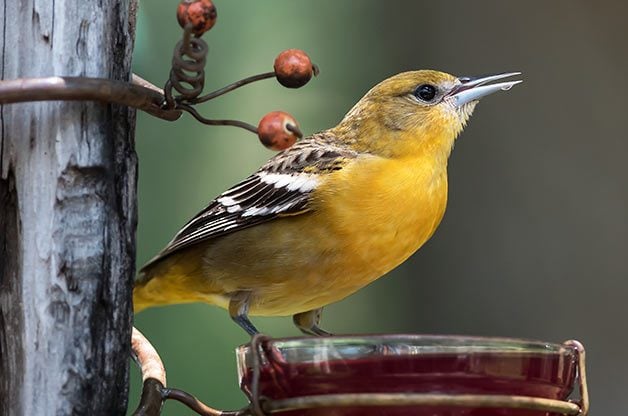
Baltimore Orioles spend the breeding season in New Jersey, with their numbers increasing during spring migration in May. They are recorded in 22% of summer checklists and up to 30% of checklists during spring migration.
Baltimore Orioles serve as colorful signs of spring in the eastern region of North America. Adult males display bright orange and black plumage with white wing bars on their black wings.
Female Baltimore Orioles have yellowish undersides, heads, and grayish-brown wings. They are about the size of a Robin but possess a more slender body. These birds belong to the blackbird family.
Icterus galbula
Length: 6.7-7.5 in (17-19 cm)
Weight: 1.1-1.4 oz (30-40 g)
Wingspan: 9.1-11.8 in (23-30 cm)
Baltimore Orioles breed in Eastern and Central States, including central-southern Canadian provinces and along the southern border of the US.
During winter, Baltimore Orioles migrate to Florida, Central America, and the Caribbean, departing as early as July.
These birds can be found high up in open woodlands, along riverbanks, and at forest edges, where they forage on insects and fruits. They often visit parks and backyards as well.
Baltimore Oriole sounds: The flute-like song of Baltimore Orioles brings joy in spring. They also produce chattering and sharp alarm calls.
Christopher McPherson, XC690956. Accessible at www.xeno-canto.org/690956.
To attract Baltimore Orioles to your backyard, offer halved oranges on a platform feeder or hang them from trees. Oriole feeders filled with sugar water can also be used. Planting fruit-bearing plants and nectar-rich plants like raspberries, crab apples, and trumpet vines will further entice them.
Fun Fact: Baltimore Orioles construct impressive hanging bag-like nests woven from various fibers.
7. Palm Warbler
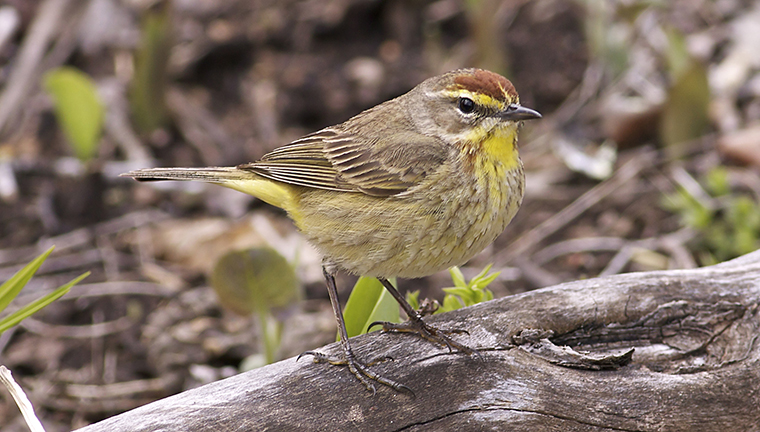
Palm Warblers can be spotted in New Jersey during migration from April to May and from September to November. They are recorded in up to 30% of checklists during these periods. However, a few individuals may linger during winter.
Palm Warblers display a rusty red patch on the top of their heads and have a brownish-olive color on the rest of their bodies. While they breed in Canada, they can be found in eastern states during migration and along the far south coast and in Florida throughout the year.
Setophaga palmarum
Length: 4.7-5.5 in (12-14 cm)
Weight: 0.3-0.5 oz (7-13 g)
Wingspan: 7.9-8.3 in (20-21 cm)
Palm Warblers primarily breed in Canada and migrate through eastern US states. Some individuals spend winter in Florida and along the southeastern coast.
These birds are commonly sighted during spring and fall migration in weedy fields, forest edges, and scrubby areas. They often forage on the ground, mingling with other bird species like sparrows, juncos, and yellow-rumped warblers.
Palm Warbler song:
Credit: Richard E. Webster, XC189604. Accessible at www.xeno-canto.org/189604.
Nests of Palm Warblers are situated in bogs and boreal forests on the ground. They are constructed using grass, sedge, and ferns woven into a cup shape, with soft grass, feathers, and animal hair lining the interior. These birds lay around five eggs.
To attract Palm Warblers to your backyard, plant native insect-attracting plants and include bayberry or hawthorn for their berries.
Fun Fact: Unlike most warblers, Palm Warblers typically walk on the ground, bobbing their tails as they search for insects.
8. Pine Warbler

Pine Warblers are recorded in 7% of summer checklists in New Jersey and are primarily observed from April to June. However, some individuals remain in the state throughout the year.
These small, plump yellow birds have olive backs, white lower bellies, and gray wingbars. Females may appear browner and exhibit more white on the belly.
Setophaga pinus
Length: 5.1-5.5 in (13-14 cm)
Weight: 0.3-0.5 oz (9-15 g)
Wingspan: 7.5-9.1 in (19-23 cm)
Pine Warblers breed in northeastern US states before migrating to southeastern US states. Some individuals remain year-round in southeastern states.
These birds can be found in pine forests, often high up in the trees. They primarily feed on caterpillars, beetles, spiders, insects, and larvae. In colder weather, they may consume fruits and seeds.
Pine Warbler Song:
Credit: Christopher McPherson, XC602052. Accessible at www.xeno-canto.org/602052.
Nests of Pine Warblers, as expected, are constructed in pine trees. They are made from twigs, bark, pine needles, and grass, bound together with spider silk. The interior of the nest is lined with feathers and animal hair. Pine Warblers lay up to five eggs, which take around two weeks to hatch, with an additional ten days for the young to fledge.
To attract Pine Warblers to your yard, provide tube feeders and platform feeders with millet, cracked corn, sunflower seeds, peanut hearts, and suet. Additionally, plant native fruit-bearing trees and vines such as bayberry, grape, sumac, and Virginia creeper.
Fun Fact: Pine Warblers are one of the few warbler species that primarily eat seeds, making them more likely to visit backyard feeders.
9. Scarlet Tanager Female
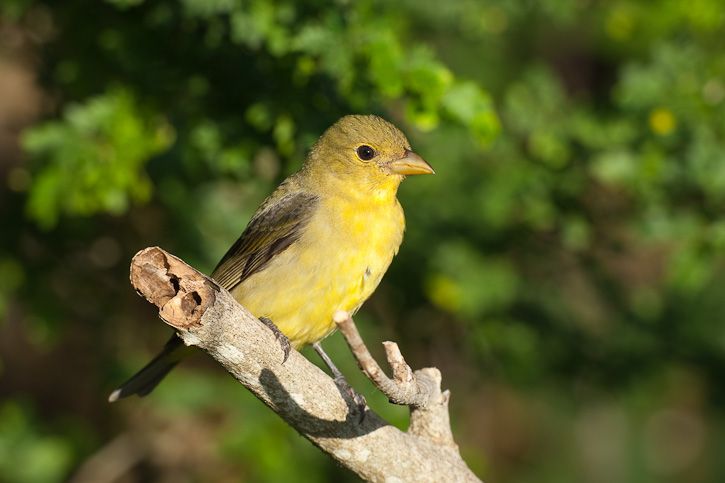
Scarlet Tanagers are observed during the summer in New Jersey and are recorded in 11% of checklists at this time. They can be seen from April to November.
Female Scarlet Tanagers display yellow plumage with darker wings and tails, similar to males after molting.
Male Scarlet Tanagers are bright red birds with black wings and tails. They have thick bills and short tails.
Piranga olivacea
Length: 6.3-6.7 in (16-17 cm)
Weight: 0.8-1.3 oz (23-38 g)
Wingspan: 9.8-11.4 in (25-29 cm)
During summer, Scarlet Tanagers breed in eastern forests before migrating to western South America. They can be observed in southeastern states during their migrations.
Scarlet Tanagers tend to stay high in the forest canopy, making them challenging to spot. However, one might catch a glimpse of their red plumage as they walk along branches while foraging for insects.
Song of the Scarlet Tanager:
Credit: Christopher McPherson, XC599850. Accessible at www.xeno-canto.org/599850.
Nests of Scarlet Tanagers are quickly constructed by females using loosely woven twigs, grass, and plant materials. The interior is lined with soft grass, pine needles, and other gentle materials. These birds lay around four eggs, which take two weeks to hatch, and approximately two weeks for the young to fledge.
To attract Scarlet Tanagers, plant berry-producing plants such as blackberries, raspberries, huckleberries, juneberries, serviceberries, mulberries, strawberries, and chokeberries.
Fun Fact: Male Scarlet Tanagers engage in singing battles, sometimes escalating to actual fights.
10. White-eyed Vireo

White-eyed Vireos spend the breeding season in New Jersey, with the majority spotted from April to mid-October. They are found in 8% of summer checklists.
White-eyed Vireos have gray heads with yellow patches around their foreheads and distinctive white eyes. They possess white chests and throats, yellow sides, greenish backs with darker wings, and two white wingbars.
Vireo griseus
Length: 4.3-5.1 in (11-13 cm)
Weight: 0.3-0.5 oz (10-14 g)
Wingspan: 6.7 in (17 cm)
During summer, White-eyed Vireos can be found across the southeastern United States, often concealed in thickets. Some individuals remain along the coast year-round. They migrate to wintering grounds along the southeastern coast of Mexico and the Caribbean.
White-eyed Vireos are frequently spotted in overgrown pastures, brambles, and areas with dense vegetation. They feed on insects, flies, and spiders. In winter, they may also consume berries.
White-eyed Vireo song:
Credit: Phoenix Birder, XC574070. Accessible at www.xeno-canto.org/574070.
Nests of White-eyed Vireos hang from branches in shrubs. They are initially shaped using spiders’ webs and then adorned with leaves, bark, and plant material. The interior of the nest is lined with soft grass, feathers, and animal hair. These birds lay around four eggs, which take two weeks to hatch, and another ten days for the young to fledge.
Fun Fact: Male and female White-eyed Vireos both sing in winter, but only the males sing during spring and summer, often vocalizing from dawn until midday.
11. Prairie Warbler
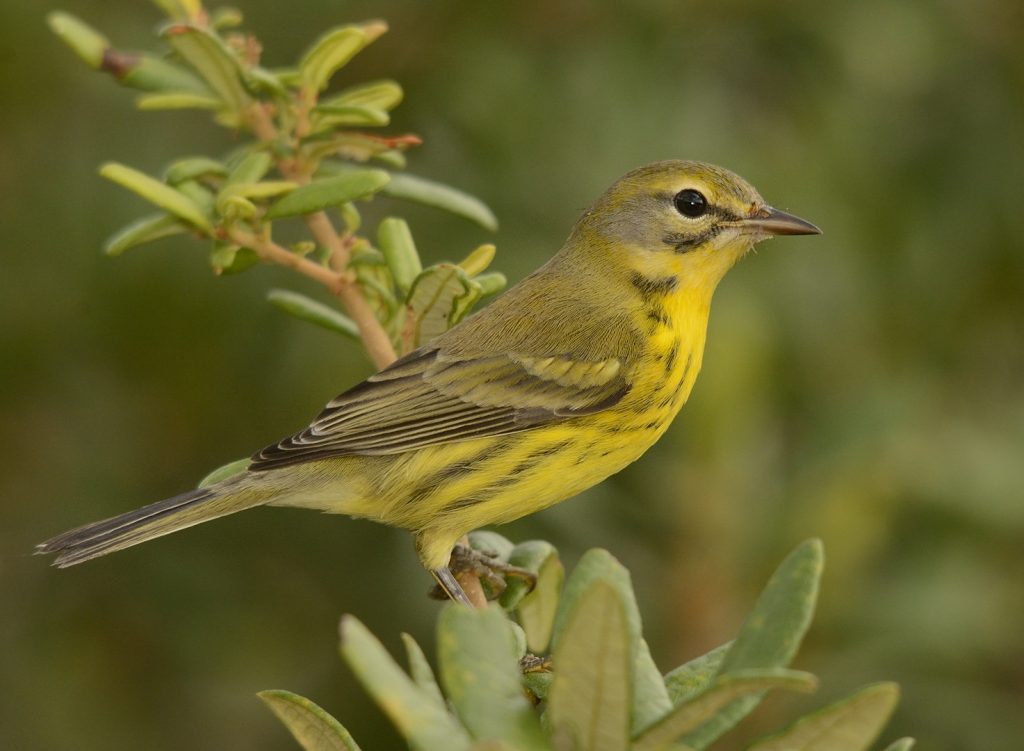
Prairie Warblers can be found in New Jersey during the breeding season and are most commonly spotted from May to September. They are recorded in 9% of summer checklists.
Prairie Warblers have bright yellow plumage with bold black streaks on their sides and backs. They also have black markings on their faces, forming a distinctive mask.
Setophaga discolor
Length: 4.3-4.7 in (11-12 cm)
Weight: 0.3-0.4 oz (9-11 g)
Wingspan: 7.5 in (19 cm)
Prairie Warblers breed in the eastern and southeastern parts of the United States. They spend their winters in the Caribbean and Central America.
These birds are often found in shrubby habitats, open woodlands, and scrubby areas, where they forage for insects, spiders, and small fruits.
Prairie Warbler Song:
Credit: Richard E. Webster, XC503188. Accessible at www.xeno-canto.org/503188.
Nests of Prairie Warblers are built in shrubs and are made from grass, rootlets, and plant fibers, lined with fine grasses and hair. They lay up to five eggs, which take around 10-12 days to hatch, and another 8-10 days for the young to leave the nest.
To attract Prairie Warblers to your backyard, create shrubby habitats with native plants and provide a water source for drinking and bathing.
Fun Fact: Prairie Warblers are known for their distinctive buzzing song, which sounds like an insect.
12. Orchard Oriole
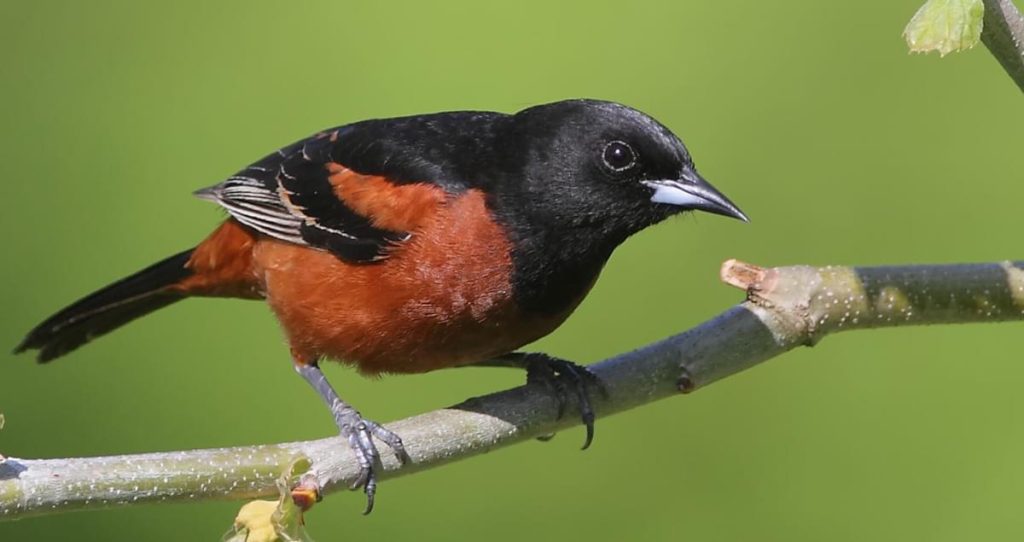
Orchard Orioles spend the breeding season in New Jersey, with their numbers increasing during spring migration in May. They are recorded in 7% of summer checklists and up to 10% during spring migration.
Male Orchard Orioles have a vibrant chestnut plumage with black wings and tail feathers. Females and immature birds are olive-yellow in color.
Icterus spurius
Length: 6.3-7.1 in (16-18 cm)
Weight: 0.8-1.0 oz (23-29 g)
Wingspan: 9.1 in (23 cm)
Orchard Orioles breed in the eastern and central parts of the United States, as well as southern Canada. During winter, they migrate to Central and South America.
These birds can be found in open woodlands, orchards, and edges of forests. They feed on insects, nectar, and fruit.
Orchard Oriole sounds: They produce a series of rich, flutelike whistles.
Credit: Kent Livezey, XC557605. Accessible at www.xeno-canto.org/557605.
Nests of Orchard Orioles are typically built on the ends of tree branches, hanging down like a pendant. They are woven from plant fibers, grasses, and fine materials. These birds lay 3-6 eggs, which incubate for around 12-14 days. The young leave the nest after 10-12 days.
To attract Orchard Orioles, provide nectar feeders, fruit feeders, and plant flowering trees and shrubs that offer nectar and insects.
Fun Fact: Male Orchard Orioles are often found singing from the treetops to attract females.
13. Blue-winged Warbler
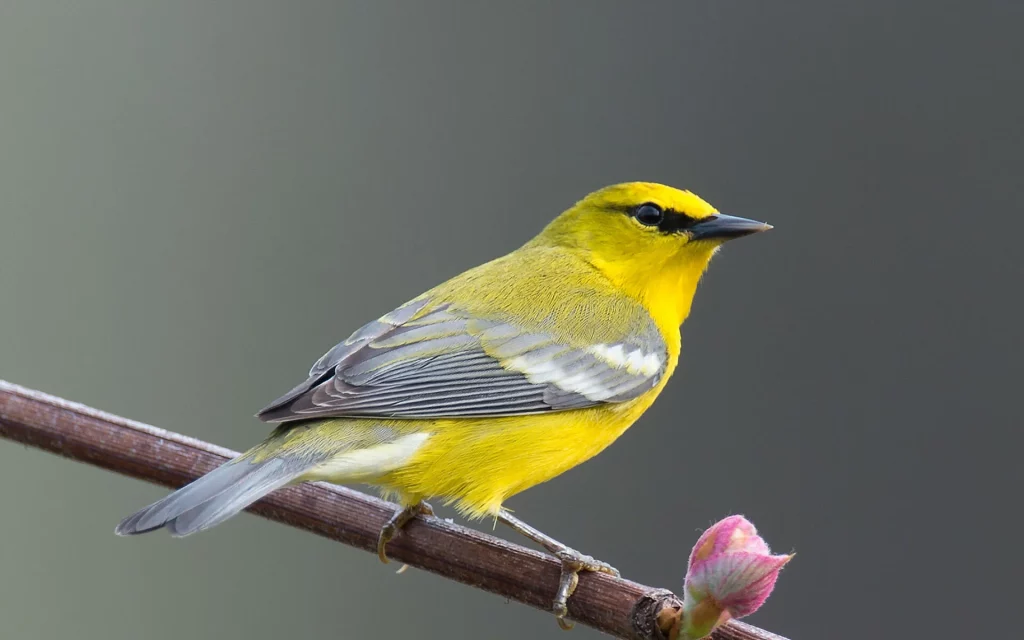
Blue-winged Warblers can be spotted in New Jersey during the breeding season and are primarily observed from May to August. They are recorded in 5% of summer checklists.
Blue-winged Warblers have bright yellow plumage with distinctive blue-gray
wings and a white belly. They also have a black line running through their eyes.
Vermivora cyanoptera
Length: 4.7-5.1 in (12-13 cm)
Weight: 0.3-0.4 oz (9-12 g)
Wingspan: 7.5-8.7 in (19-22 cm)
Blue-winged Warblers breed in the eastern United States and parts of southern Canada. They spend their winters in Central and South America.
These birds are often found in open woodlands, shrubby areas, and early successional habitats. They feed on insects, spiders, and small fruits.
Blue-winged Warbler Song:
Credit: Dan Lane, XC105678. Accessible at www.xeno-canto.org/105678.
Nests of Blue-winged Warblers are constructed on or near the ground in shrubby vegetation. They are made from grasses, leaves, and plant fibers, lined with finer materials. These birds lay 3-7 eggs, which hatch after approximately 10-12 days. The young fledge from the nest around 8-11 days later.
To attract Blue-winged Warblers, create habitats with shrubs, young trees, and native plants that provide food and cover.
Fun Fact: Blue-winged Warblers hybridize with the Golden-winged Warblers, resulting in a hybrid species known as the Brewster’s Warbler or Lawrence’s Warbler.
14. Yellow-throated Vireo
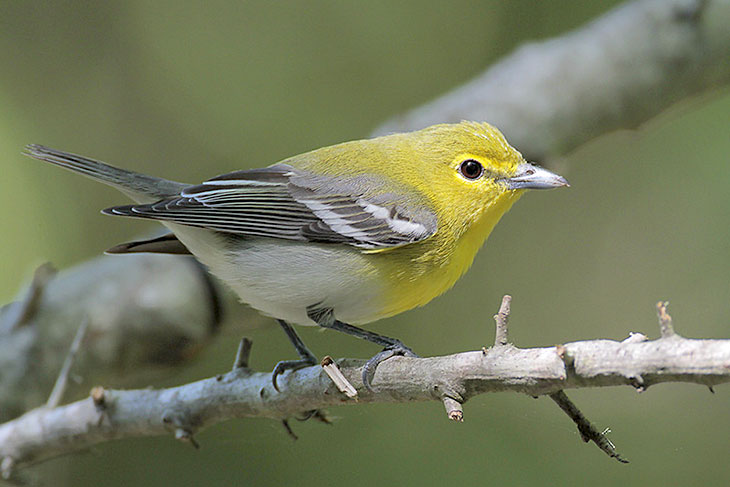
Yellow-throated Vireos spend the breeding season in New Jersey and are primarily spotted from May to August. They are recorded in 3% of summer checklists.
Yellow-throated Vireos have yellow plumage with a gray head and upperparts. They have a distinct black line through their eyes and a yellow throat.
Vireo flavifrons
Length: 5.5-5.9 in (14-15 cm)
Weight: 0.4-0.6 oz (11-17 g)
Wingspan: 8.7-9.1 in (22-23 cm)
Yellow-throated Vireos breed in the eastern United States and parts of southern Canada. They spend their winters in Central and South America.
These birds are often found in mature forests, especially those near water. They forage for insects among the tree branches.
Yellow-throated Vireo song:
Credit: Peter Ward, XC354855. Accessible at www.xeno-canto.org/354855.
Nests of Yellow-throated Vireos are suspended from branches in tall trees, usually near the trunk. They are made from bark strips, plant fibers, and spider silk, with a cup-shaped interior lined with fine materials. These birds lay 3-5 eggs, which incubate for around 12-14 days. The young leave the nest after approximately 9-11 days.
To attract Yellow-throated Vireos, maintain a mature forest habitat with a diversity of tree species and provide a water source.
Fun Fact: Yellow-throated Vireos are known for their loud and persistent songs, often repeated in a series of phrases.
15. Hooded Warbler
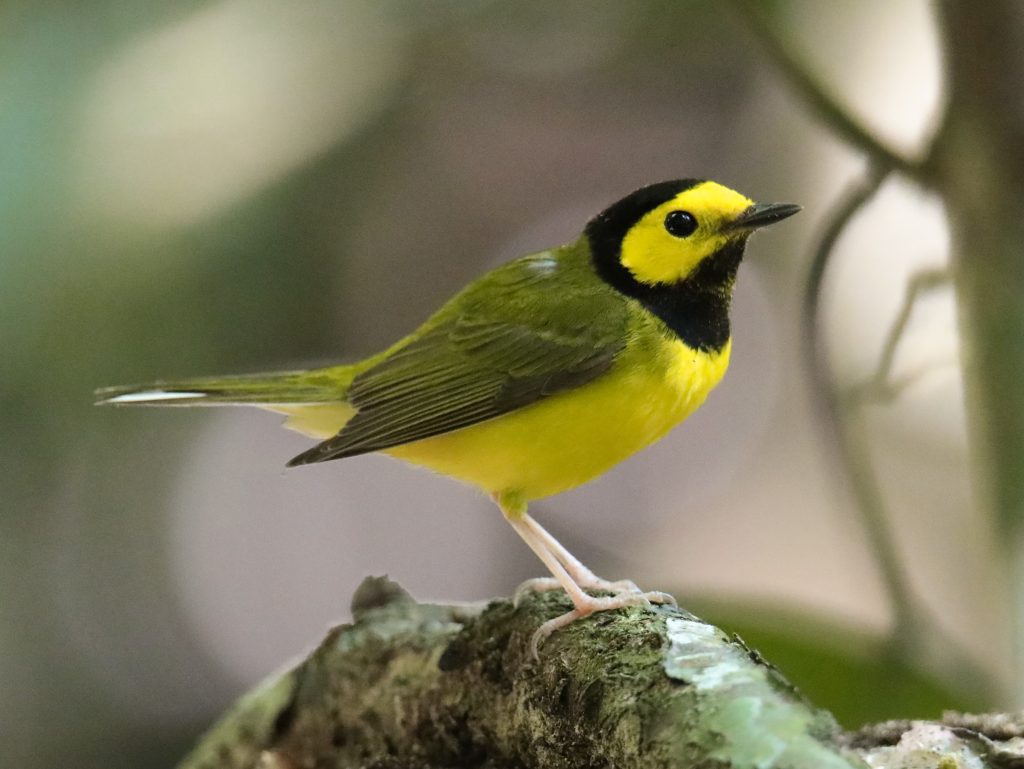
Hooded Warblers can be found in New Jersey during the breeding season and are primarily observed from May to August. They are recorded in 3% of summer checklists.
Hooded Warblers have bright yellow plumage with a black hood covering their head and throat. The females have a duller olive-gray hood.
Setophaga citrina
Length: 4.3-4.7 in (11-12 cm)
Weight: 0.3-0.4 oz (9-11 g)
Wingspan: 6.7-7.5 in (17-19 cm)
Hooded Warblers breed in the eastern United States and parts of southern Canada. They spend their winters in Central America and northern South America.
These birds are often found in dense shrubby habitats, including forest understory and thickets. They forage for insects and spiders on or near the ground.
Hooded Warbler Song:
Credit: Kent Livezey, XC557653. Accessible at www.xeno-canto.org/557653.
Nests of Hooded Warblers are built on the ground, usually in a depression under shrubs or fallen leaves. They are constructed from leaves, bark, and plant fibers, with a soft grass lining. These birds lay 3-5 eggs, which hatch after approximately 12-14 days. The young fledge from the nest around 9-11 days later.
To attract Hooded Warblers, create dense shrubby habitats with a variety of native plants and provide water sources.
Fun Fact: Hooded Warblers have a unique foraging behavior known as “tail-wagging,” where they flick their tails up and down while searching for insects on leaves and branches.
16. Yellow-throated Warbler
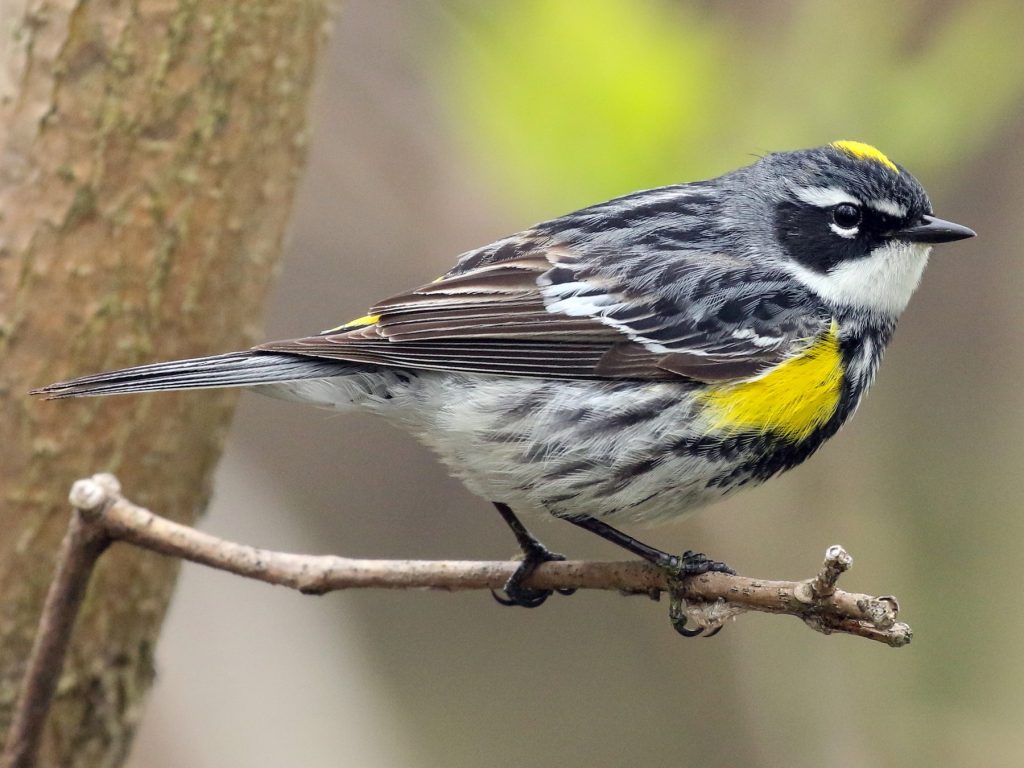
Yellow-throated Warblers can be spotted in New Jersey during the breeding season, with their peak activity from May to August. They are recorded in 2% of summer checklists.
Yellow-throated Warblers have bright yellow plumage with black stripes on their sides. They have a white belly and a distinctive yellow throat.
Setophaga dominica
Length: 5.5-6.3 in (14-16 cm)
Weight: 0.4-0.6 oz (12-17 g)
Wingspan: 8.7-9.4 in (22-24 cm)
Yellow-throated Warblers breed in the southeastern United States, primarily in bottomland forests and swampy areas. They spend their winters in southern Florida, the Caribbean, and Central America.
These birds are often found in the upper canopy of trees, where they forage for insects and spiders.
Yellow-throated Warbler song:
Credit: Greg Irving, XC616179. Accessible at www.xeno-canto.org/616179.
Nests of Yellow-throated Warblers are constructed on tree branches, typically near the trunk. They are made from bark strips, plant fibers, and spider silk, with a cup-shaped interior lined with finer materials. These birds lay 3-4 eggs, which incubate for around 12-14 days. The young leave the nest after approximately 10-12 days.
To attract Yellow-throated Warblers, maintain mature forests with tall trees and provide a water source.
Fun Fact: Yellow-throated Warblers have a unique feeding behavior known as “gleaning,” where they search for insects by carefully inspecting leaves and branches.
17. Prothonotary Warbler
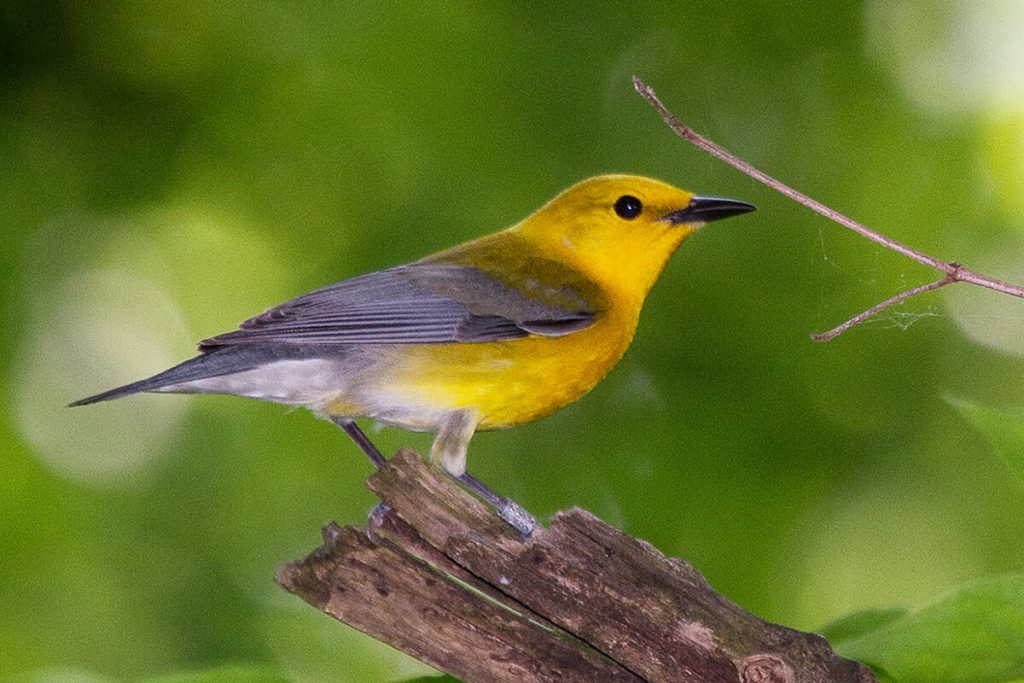
Prothonotary Warblers can be spotted in New Jersey during the breeding season, primarily from April to August. They are recorded in 2% of summer checklists.
Prothonotary Warblers have vibrant yellow plumage with blue-gray wings and a distinctive orange crown. They have a relatively long beak and short tail.
Protonotaria citrea
Length: 4.3-5.1 in (11-13 cm)
Weight: 0.3-0.4 oz (9-12 g)
Wingspan: 6.7-7.5 in (17-19 cm)
Prothonotary Warblers breed in the eastern United States and parts of southern Canada. They spend their winters in Central America and northern South America.
These birds are often found in swampy or wetland habitats with standing water, where they forage for insects and spiders.
Prothonotary Warbler Song:
Credit: Andrew Spencer, XC268504. Accessible at www.xeno-canto.org/268504.
Nests of Prothonotary Warblers are built in natural or artificial cavities near water, such as tree cavities or nest boxes. They are constructed from moss, leaves, bark, and plant fibers, with a soft grass lining. These birds lay 3-7 eggs, which hatch after approximately 12-14 days. The young fledge from the nest around 9-11 days later.
To attract Prothonotary Warblers, provide nest boxes near water sources and maintain wetland or swampy areas with suitable nesting sites.
Fun Fact: Prothonotary Warblers are the only eastern warblers that nest in tree cavities, making them unique among their relatives.
18. Summer Tanager
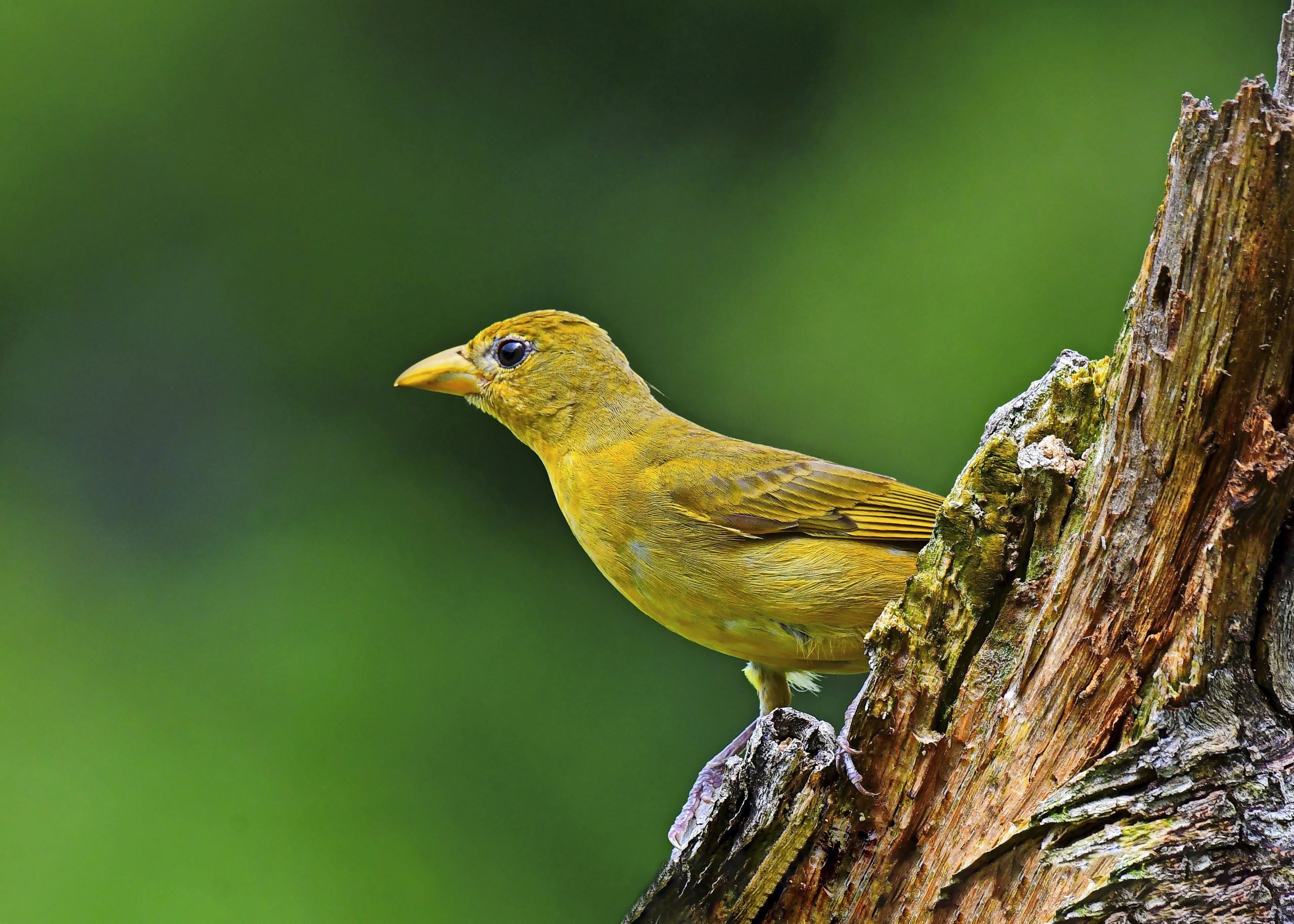
Summer Tanagers spend the breeding season in New Jersey, primarily from May to August. They are recorded in 1% of summer checklists.
Summer Tanagers have varying plumage colors depending on their age and sex. Adult males are entirely red, while females and immature birds are yellowish with hints of red.
Piranga rubra
Length: 6.3-7.1 in (16-18 cm)
Weight: 1.1-1.3 oz (32-37 g)
Wingspan: 10.2-11.8 in (26-30 cm)
Summer Tanagers breed in the southeastern United States and parts of Mexico. They spend their winters in Central and northern South America.
These birds are often found in forested habitats, including open woodlands and edges. They forage for insects, bees, wasps, and fruits.
Summer Tanager sounds: They produce a distinct, robin-like song.
Credit: Andrew Spencer, XC436861. Accessible at www.xeno-canto.org/436861.
Nests of Summer Tanagers are built in tree branches, usually near the trunk. They are constructed from twigs, grass, plant fibers, and spider silk, with a soft grass lining. These birds lay 2-5 eggs, which incubate for around 12-13 days. The young leave the nest after approximately 9-11 days.
To attract Summer Tanagers, provide fruit feeders and maintain diverse forested habitats with abundant insect prey.
Fun Fact: Male Summer Tanagers sometimes practice a behavior called “anting,” where they rub ants on their feathers, possibly to repel parasites or obtain chemical substances from the ants.
19. Orange-crowned Warbler
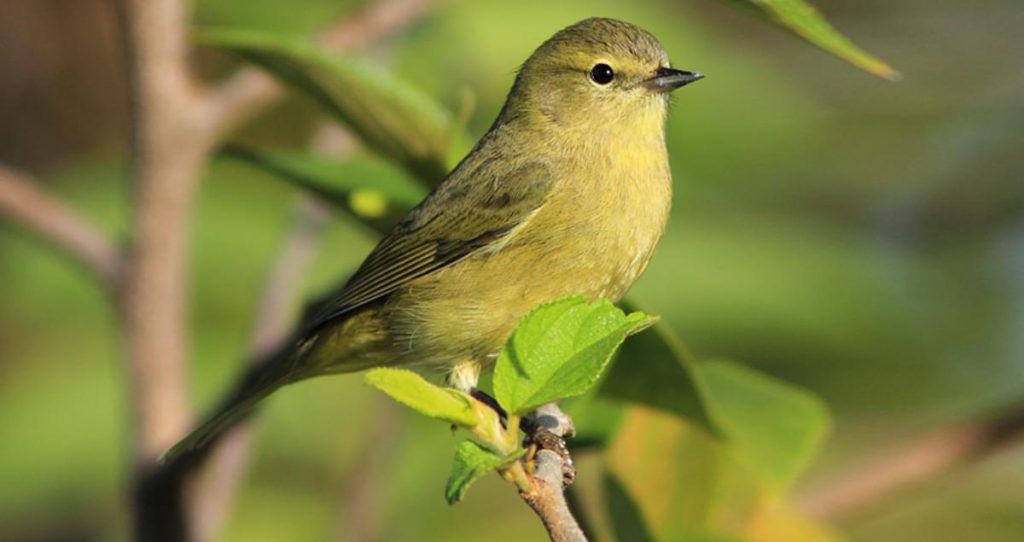
Orange-crowned Warblers can be spotted in New Jersey during migration, primarily in the spring and fall. They are recorded in up to 5% of checklists during these times.
Orange-crowned Warblers have a relatively plain appearance, with olive-green plumage and a yellowish or olive crown that is often concealed.
Leiothlypis celata
Length: 4.7-5.1 in (12-13 cm)
Weight: 0.3-0.4 oz (9-12 g)
Wingspan: 6.7-7.5 in (17-19 cm)
Orange-crowned Warblers breed in the western parts of North America, including Alaska and parts of Canada. They spend their winters in the southern United States, Mexico, and Central America.
During migration, these birds can be found in various habitats, including woodlands, shrubby areas, and gardens. They forage for insects, spiders, and small fruits.
Orange-crowned Warbler sounds:
Credit: Andrew Spencer, XC350714. Accessible at www.xeno-canto.org/350714.
Nests of Orange-crowned Warblers are built in low shrubs or vegetation, often concealed and difficult to find. They are constructed from twigs, grass, and plant fibers, with a soft grass lining. These birds lay 3-6 eggs, which hatch after approximately 12-14 days. The young fledge from the nest around 9-11 days later.
To attract Orange-crowned Warblers during migration, provide shrubby habitats with ample food sources and water.
Fun Fact: The orange crown of the Orange-crowned Warbler is usually not visible unless the bird is excited or agitated.
20. Western Kingbird

Western Kingbirds can be spotted in New Jersey during migration, primarily in the spring and fall. They are recorded in up to 3% of checklists during these times.
Western Kingbirds have a bold appearance with a gray head, bright yellow belly, and olive-gray upperparts. They have a distinct white outer tail feather.
Tyrannus verticalis
Length: 7.1-8.3 in (18-21 cm)
Weight: 1.1-1.4 oz (31-40 g)
Wingspan: 12.6-14.2 in (32-36 cm)
Western Kingbirds breed in western North America, primarily in open habitats such as grasslands and meadows. They spend their winters in Central and South America.
During migration, these birds can be found in various habitats, including open woodlands, fields, and gardens. They forage for insects, including flying insects like bees and wasps.
Western Kingbird call:
Credit: Andrew Spencer, XC173262. Accessible at www.xeno-canto.org/173262.
Nests of Western Kingbirds are built on horizontal branches of trees or on structures such as utility poles. They are constructed from twigs, grass, rootlets, and plant fibers, with a soft lining of feathers and animal hair. These birds lay 3-7 eggs, which incubate for around 14-16 days. The young leave the nest after approximately 16-19 days.
To attract Western Kingbirds during migration, provide open perching spots and maintain open habitats with abundant insect prey.
Fun Fact: Western Kingbirds are known for their aggressive behavior, often engaging in aerial pursuits with larger birds to defend their nesting territories.
21. Palm Warbler

Palm Warblers can be spotted in New Jersey during migration, primarily in the spring and fall. They are recorded in up to 30% of checklists during these times. However, a few individuals may also overwinter in the state.
Palm Warblers have a brownish-olive back with a
rusty red patch on the top of their head. They have a pale yellow underbelly and white spots on their tail feathers.
Setophaga palmarum
Length: 4.7-5.5 in (12-14 cm)
Weight: 0.3-0.5 oz (7-13 g)
Wingspan: 7.9-8.3 in (20-21 cm)
Palm Warblers breed predominantly in Canada and can be seen during migration in eastern US states. Some winter in Florida and along the southeastern coast.
These birds are often found in weedy fields, forest edges, and scrubby areas during migration. They forage on the ground, often in the company of other birds, such as sparrows and yellow-rumped warblers.
Palm Warbler song:
Credit: Richard E. Webster, XC189604. Accessible at www.xeno-canto.org/189604.
Nests of Palm Warblers are in bogs and boreal forests on the ground. They are made from grass, sedge, and ferns woven into a cup shape and lined with soft grass, feathers, and animal hair. These birds lay around five eggs.
To attract Palm Warblers during migration, create habitat with native plants that provide food and cover, especially in open areas with low vegetation.
Fun Fact: Unlike most warblers, Palm Warblers often bob their tails up and down while foraging on the ground.
22. Magnolia Warbler
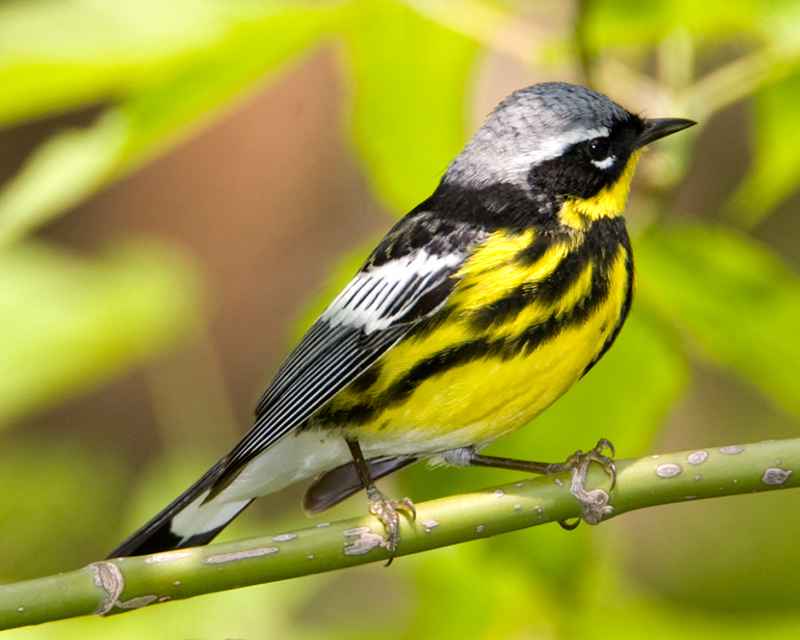
Magnolia Warblers can be spotted in New Jersey during migration, primarily in the spring and fall. They are recorded in up to 10% of checklists during these times.
Magnolia Warblers have a striking appearance with a black face, white eye crescents, and a bold yellow breast and belly. They have black streaks on their back and white wing bars.
Setophaga magnolia
Length: 4.3-5.1 in (11-13 cm)
Weight: 0.3-0.4 oz (9-11 g)
Wingspan: 7.5-8.7 in (19-22 cm)
Magnolia Warblers breed in the boreal forests of Canada and parts of the northeastern United States. They spend their winters in Central and northern South America.
During migration, these birds can be found in various habitats, including forests, woodlands, and gardens. They forage for insects, spiders, and small fruits.
Magnolia Warbler sounds:
Credit: Andrew Spencer, XC389881. Accessible at www.xeno-canto.org/389881.
Nests of Magnolia Warblers are built on or near the ground in dense vegetation. They are constructed from twigs, grass, moss, and plant fibers, with a soft lining of feathers and animal hair. These birds lay 4-5 eggs, which incubate for around 11-13 days. The young leave the nest after approximately 9-11 days.
To attract Magnolia Warblers during migration, provide diverse forested habitats with suitable food sources and water.
Fun Fact: The name “Magnolia” in Magnolia Warbler refers to the resemblance of its plumage to the flowers of the magnolia tree.
23. Black-throated Green Warbler

Black-throated Green Warblers can be spotted in New Jersey during migration, primarily in the spring and fall. They are recorded in up to 15% of checklists during these times.
Black-throated Green Warblers have bright yellow plumage with a black throat and upper breast. They have olive-green wings and back, with white wing bars.
Setophaga virens
Length:4.7-5.1 in (12-13 cm)
Weight: 0.3-0.4 oz (9-11 g)
Wingspan: 7.5-8.7 in (19-22 cm)
Black-throated Green Warblers breed in the northeastern United States and parts of Canada. They spend their winters in the Caribbean and Central America.
During migration, these birds can be found in various habitats, including forests, woodlands, and shrubby areas. They forage for insects, spiders, and small fruits.
Black-throated Green Warbler song:
Credit: Matthew Pendleton, XC440011. Accessible at www.xeno-canto.org/440011.
Nests of Black-throated Green Warblers are built on or near the ground in dense vegetation. They are constructed from twigs, grass, moss, and plant fibers, with a soft lining of feathers and animal hair. These birds lay 4-5 eggs, which incubate for around 11-14 days. The young leave the nest after approximately 9-12 days.
To attract Black-throated Green Warblers during migration, provide diverse forested habitats with suitable food sources and water.
Fun Fact: Black-throated Green Warblers have a distinctive song that sounds like “zoo-zee, zoo-zoo-zee.”
24. Nashville Warbler
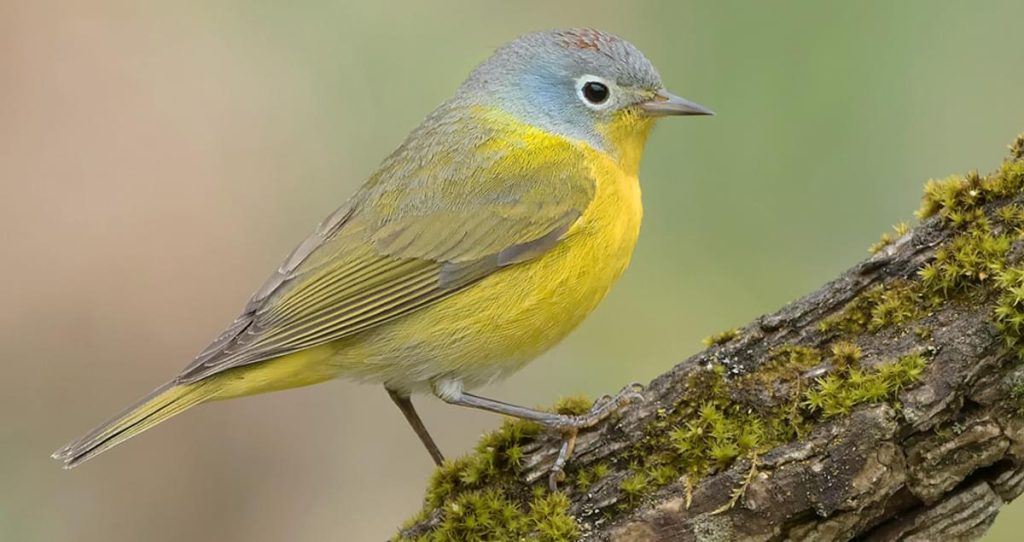
Nashville Warblers can be spotted in New Jersey during migration, primarily in the spring and fall. They are recorded in up to 8% of checklists during these times.
Nashville Warblers have a relatively plain appearance with olive-green upperparts and a yellow underbelly. They have a distinctive gray head with a white eye ring and a patch of gray on the crown.
Leiothlypis ruficapilla
Length: 4.3-4.7 in (11-12 cm)
Weight: 0.3-0.4 oz (9-11 g)
Wingspan: 6.7-7.5 in (17-19 cm)
Nashville Warblers breed in parts of Canada and the northern United States. They spend their winters in southern Central America and northern South America.
During migration, these birds can be found in various habitats, including forests, woodlands, and gardens. They forage for insects, spiders, and small fruits.
Nashville Warbler sounds:
Credit: Andrew Spencer, XC436315. Accessible at www.xeno-canto.org/436315.
Nests of Nashville Warblers are built on or near the ground in dense vegetation. They are constructed from grass, moss, and plant fibers, with a soft lining of feathers and animal hair. These birds lay 4-5 eggs, which incubate for around 10-13 days. The young leave the nest after approximately 9-11 days.
To attract Nashville Warblers during migration, provide diverse habitats with suitable food sources and water.
Fun Fact: The name “Nashville” in Nashville Warbler comes from the location where the species was first observed and described.
25. Cape May Warbler

Cape May Warblers can be spotted in New Jersey during migration, primarily in the spring and fall. They are recorded in up to 12% of checklists during these times.
Cape May Warblers have a unique appearance with a combination of yellow, black, and chestnut plumage. They have a yellow face, throat, and upper breast, with black streaks and chestnut patches on their sides and back.
Setophaga tigrina
Length: 4.3-5.1 in (11-13 cm)
Weight: 0.4-0.5 oz (11-15 g)
Wingspan: 7.1-8.3 in (18-21 cm)
Cape May Warblers breed in the boreal forests of Canada and parts of the northeastern United States. They spend their winters in the Caribbean and northern South America.
During migration, these birds can be found in various habitats, including forests, woodlands, and gardens. They forage for insects, particularly feeding on the nectar of flowering trees.
Cape May Warbler song:
Credit: Andrew Spencer, XC378167. Accessible at www.xeno-canto.org/378167.
Nests of Cape May Warblers are built in coniferous trees, typically near the end of branches. They are constructed from twigs, lichen, and plant fibers, with a soft lining of feathers and animal hair. These birds lay 4-7 eggs, which incubate for around 12-14 days. The young leave the nest after approximately 9-12 days.
To attract Cape May Warblers during migration, provide diverse forested habitats with suitable food sources and water.
Fun Fact: Cape May Warblers have a unique feeding behavior where they extract and feed on the sugary liquid from the flower buds of trees, such as the eastern hemlock.
26. Blackburnian Warbler
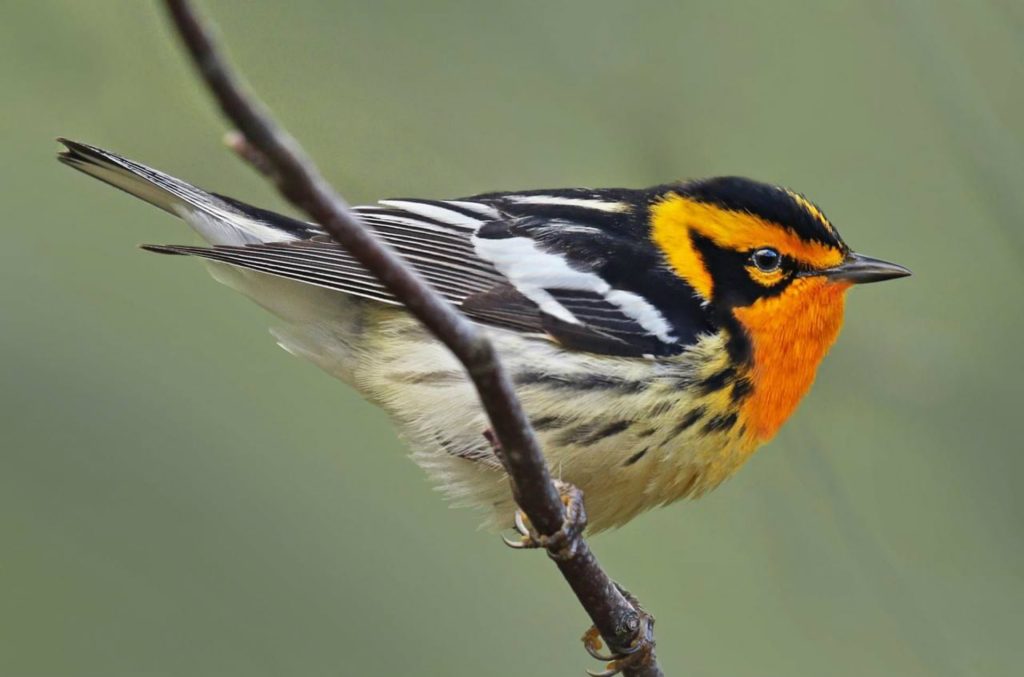
Blackburnian Warblers can be spotted in New Jersey during migration, primarily in the spring and fall. They are recorded in up to 8% of checklists during these times.
Blackburnian Warblers have a stunning appearance with a black throat and upper breast, bright orange or flame-colored face and neck, and yellow underparts. They have black streaks on their back and white wing bars.
Setophaga fusca
Length: 4.3-5.1 in (11-13 cm)
Weight: 0.3-0.4 oz (9-11 g)
Wingspan: 7.1-8.3 in (18-21 cm)
Blackburnian Warblers breed in the northeastern United States and parts of Canada. They spend their winters in Central and northern South America.
During migration, these birds can be found in various habitats, including forests, woodlands, and gardens. They forage for insects, spiders, and small fruits.
Blackburnian Warbler sounds:
Credit: Andrew Spencer, XC356380. Accessible at www.xeno-canto.org/356380.
Nests of Blackburnian Warblers are built on or near the end of branches in coniferous or mixed forests. They are constructed from twigs, grass, moss, and plant fibers, with a soft lining of feathers and animal hair. These birds lay 3-4 eggs, which incubate for around 12-13 days. The young leave the nest after approximately 9-11 days.
To attract Blackburnian Warblers during migration, provide diverse forested habitats with suitable food sources and water.
Fun Fact: The Blackburnian Warbler is named after Anna Blackburne, an English botanist who lived in the 18th century.
27. Bay-breasted Warbler
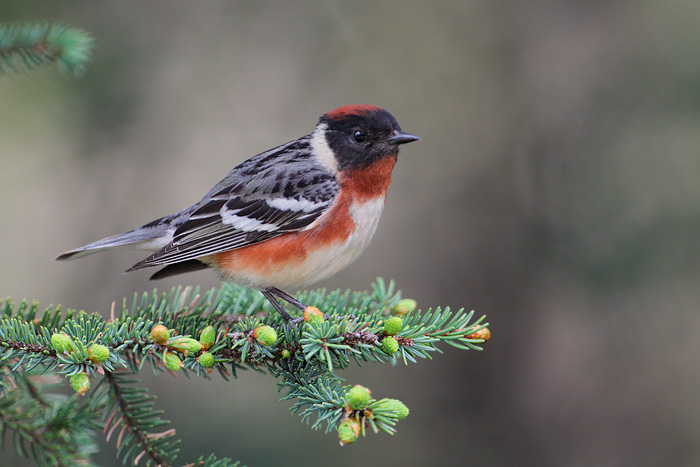
Bay-breasted Warblers can be spotted in New Jersey during migration, primarily in the spring and fall. They are recorded in up to 8% of checklists during these times.
Bay-breasted Warblers have a distinctive appearance with a grayish head, reddish-brown upperparts, and a pale yellow underbelly. Adult males have a rich chestnut coloration on their crown, throat, and sides.
Setophaga castanea
Length: 4.7-5.1 in (12-13 cm)
Weight: 0.4-0.5 oz (11-14 g)
Wingspan: 7.9-8.7 in (20-22 cm)
Bay-breasted Warblers breed in the boreal forests of Canada and parts of the northeastern United States. They spend their winters in Central and northern South America.
During migration, these birds can be found in various habitats, including forests, woodlands, and gardens. They forage for insects, spiders, and small fruits.
Bay-breasted Warbler sounds:
Credit: Andrew Spencer, XC355893. Accessible at www.xeno-canto.org/355893.
Nests of Bay-breasted Warblers are built in coniferous trees, typically near the end of branches. They are constructed from twigs, grass, moss, and plant fibers, with a soft lining of feathers and animal hair. These birds lay 3-5 eggs, which incubate for around 12-13 days. The young leave the nest after approximately 9-11 days.
To attract Bay-breasted Warblers during migration, provide diverse forested habitats with suitable food sources and water.
Fun Fact: The Bay-breasted Warbler is known for its “fallout” events during migration, where large numbers of these birds can appear in specific locations after a period of strong winds or weather conditions that displace them from their normal migration route.
28. Blackpoll Warbler

Blackpoll Warblers can be spotted in New Jersey during migration, primarily in the spring and fall. They are recorded in up to 15% of checklists during these times.
Blackpoll Warblers have a plain appearance with black streaks on their white underparts, a black cap, and grayish upperparts. Adult males develop a distinct black-and-white pattern during the breeding season.
Setophaga striata
Length: 4.7-5.5 in (12-14 cm)
Weight: 0.3-0.5 oz (9-14 g)
Wingspan: 8.7-9.8 in (22-25 cm)
Blackpoll Warblers breed in the boreal forests of Canada and parts of the northeastern United States. They spend their winters in northern South America.
During migration, these birds can be found in various habitats, including forests, woodlands, and gardens. They forage for insects, spiders, and small fruits.
Blackpoll Warbler sounds:
Credit: Andrew Spencer, XC475221. Accessible at www.xeno-canto.org/475221.
Nests of Blackpoll Warblers are built on or near the end of branches in coniferous trees. They are constructed from twigs, grass, moss, and plant fibers, with a soft lining of feathers and animal hair. These birds lay 4-5 eggs, which incubate for around 10-12 days. The young leave the nest after approximately 9-11 days.
To attract Blackpoll Warblers during migration, provide diverse forested habitats with suitable food sources and water.
Fun Fact: The Blackpoll Warbler is known for its remarkable long-distance migration. During fall migration, they undertake a non-stop flight of over 1,800 miles (2,900 km) across the Atlantic Ocean from the northeastern United States and eastern Canada to South America.
29. Connecticut Warbler
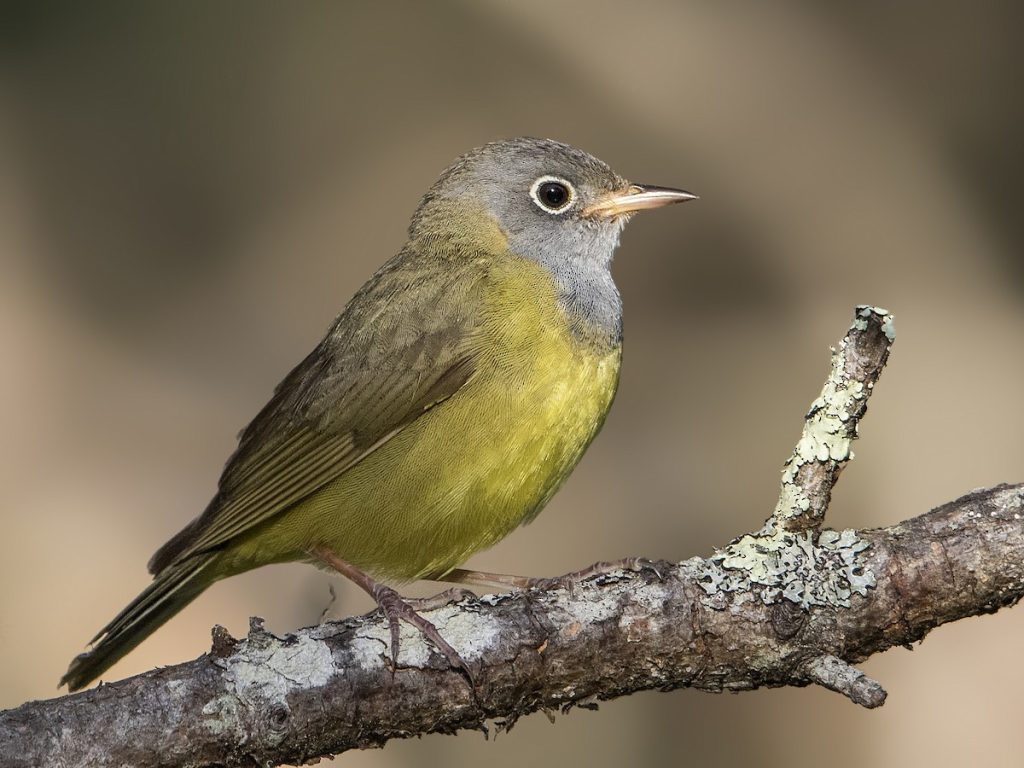
Connecticut Warblers can be spotted in New Jersey during migration, primarily in the spring and fall. They are recorded in up to 5% of checklists during these times.
Connecticut Warblers have a subtle appearance with olive-brown upperparts and a yellow underbelly. They have a gray head with a distinct white eye ring and a small, thin bill.
Oporornis agilis
Length: 5.1-5.9 in (13-15 cm)
Weight: 0.4-0.6 oz (10-17 g)
Wingspan: 8.3-9.8 in (21-25 cm)
Connecticut Warblers breed in the boreal forests of Canada and parts of the northern United States. They spend their winters in Central and northern South America.
During migration, these birds can be found in various habitats, including forests, woodlands, and wet areas. They forage for insects, spiders, and small fruits.
Connecticut Warbler song:
Credit: Jonathon Jongsma, XC355437. Accessible at www.xeno-canto.org/355437.
Nests of Connecticut Warblers are built on or near the ground in dense vegetation, often near wet areas. They are constructed from leaves, grass, moss, and plant fibers, with a soft lining of feathers and animal hair. These birds lay 4-5 eggs, which incubate for around 12-13 days. The young leave the nest after approximately 10-12 days.
To attract Connecticut Warblers during migration, provide diverse habitats with suitable food sources and water.
Fun Fact: Despite its name, the Connecticut Warbler is not commonly seen in the state of Connecticut. The species was first described there, leading to its name.
30. Mourning Warbler

Mourning Warblers can be spotted in New Jersey during migration, primarily in the spring and fall. They are recorded in up to 8% of checklists during these times.
Mourning Warblers have a subtle appearance with olive-green upperparts, a yellow underbelly, and a gray head. Adult males have a distinct black mask across their face.
Geothlypis philadelphia
Length: 4.3-5.1 in (11-13 cm)
Weight: 0.3-0.4 oz (9-11 g)
Wingspan: 7.5-8.3 in (19-21 cm)
Mourning Warblers breed in the boreal forests of Canada and parts of the northeastern United States. They spend their winters in Central and northern South America.
During migration, these birds can be found in various habitats, including forests, woodlands, and shrubby areas. They forage for insects, spiders, and small fruits.
Mourning Warbler song:
Credit: Jonathon Jongsma, XC493692. Accessible at www.xeno-canto.org/493692.
Nests of Mourning Warblers are built on or near the ground in dense vegetation. They are constructed from leaves, grass, moss, and plant fibers, with a soft lining of feathers and animal hair. These birds lay 3-5 eggs, which incubate for around 11-12 days. The young leave the nest after approximately 9-10 days.
To attract Mourning Warblers during migration, provide diverse habitats with suitable food sources and water.
Fun Fact: The Mourning Warbler is known for its habit of skulking in dense vegetation, making it challenging to observe, despite being relatively common during migration.
